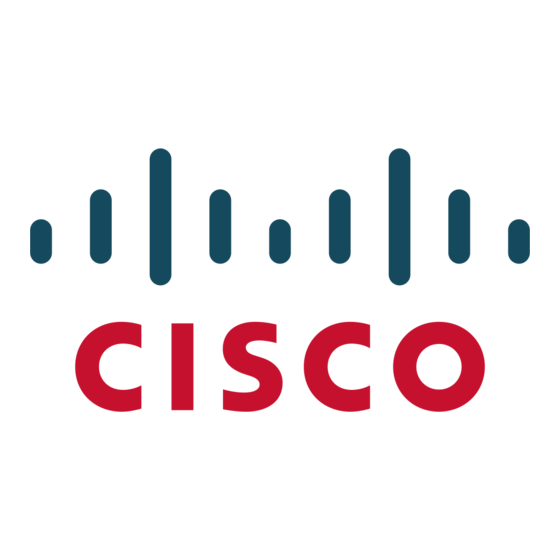Cisco 3550-24 - Catalyst SMI Switch Datasheet - Page 5
Browse online or download pdf Datasheet for Switch Cisco 3550-24 - Catalyst SMI Switch. Cisco 3550-24 - Catalyst SMI Switch 21 pages. Cisco catalyst 3550-48: supplementary guide
Also for Cisco 3550-24 - Catalyst SMI Switch: Product Bulletin (3 pages), Product Bulletin (5 pages), Questions And Answers (9 pages)

The Cisco Catalyst 3550 is capable of performing rate limiting via its support of the Cisco Committed Information
Rate (CIR) functionality. Through CIR, bandwidth can be guaranteed in increments as low as 8 Kbps. Bandwidth
can be allocated based on several criteria, including MAC source address, MAC destination address, IP source
address, IP destination address, and TCP/UDP port number. Per-VLAN, per-port policing on the ingress is also
supported. Each Cisco Catalyst 3550 Series 10/100 port supports eight aggregate or individual ingress policers and
eight aggregate egress policers. Each Cisco Catalyst 3550 Series Gigabit Ethernet port supports 128 aggregate or
individual ingress policers and 8 aggregate egress policers. This gives service providers the flexibility to offer more
granular services.
In addition, the Cisco Catalyst 3550 Series also supports hardware-based high-performance IP routing, such as Open
Shortest Path First (OSPF); Interior Gateway Routing Protocol (IGRP); Enhanced IGRP (EIRGP); Border Gateway
Protocol (BGP); Routing Information Protocol (RIP) and RIP v2; Protocol-Independent Multicast (PIM); and
hardware-based IGMP snooping for multicast applications. For voice over IP (VoIP), the Cisco Catalyst 3550 Series
supports Auxiliary VLAN. Together with the superior QoS and rate-limiting features mentioned above, service
providers can build a flexible network with the Cisco Catalyst 3550 Series to provide voice, video, and high-speed
data services from a single network architecture.
Service Availability through Resiliency Enhancements and Network Redundancy
The Cisco Catalyst 3550 Series provides a rich set of resiliency enhancement features to ensure quick fail-over
recovery and create a high-availability network. The IEEE 802.1w Rapid Spanning Tree standard allows the service
provider to achieve subsecond spanning tree convergence times to maximize network stability and reliability. The
IEEE 802.1s Multiple Spanning Tree standard can be deployed in conjunction with 802.1w to improve the scalability
of the STP by grouping VLANs into spanning tree instances, as well as by providing backward compatibility to
devices running the 802.1D STP.
In addition, service providers can enable Bridge Protocol Data Unit (BPDU) guard and Spanning Tree Root Guard
(STRG) to enhance the reliability of their networks. BPDU guard allows the service provider to shut down STP
PortFast-enabled interfaces to avoid receiving BPDUs from their customers' networks. STRG prevents customer
devices outside the service provider's network from becoming STP root nodes.
The Cisco Catalyst 3550 Series enables the service provider to construct a highly redundant network. Per-VLAN
Spanning Tree Plus (PVST+) allows the service provider to implement Layer 2 load-sharing on redundant links,
efficiently utilizing the extra capacity inherent in a redundant design. For a Layer 3 network, Cisco Hot Standby
Router Protocol (HSRP) creates redundant fail-safe routing topologies, and equal-cost routing provides Layer 3
®
load-balancing and redundancy. Service providers can also utilize EtherChannel
technology to aggregate up to
16 Gbps through Gigabit EtherChannel and up to 1.6 Gbps through Fast EtherChannel. The EtherChannel
technology enhances fault tolerance and offers higher speed aggregated bandwidth between switches and to routers.
In addition to resiliency and network redundancy advantages, the Cisco Catalyst 3550 Series enables metro network
scalability at the access edge through its support of the Cisco CWDM GBIC Solution. This solution allows service
providers to scale their bandwidth without deploying additional fiber. The service provider can scale up to eight
Gigabits of bandwidth on a pair of single-mode fibers at distances up to 120 km. With the support for CWDM GBICs
on the Cisco Catalyst 3550 Series, service providers can aggregate multiple Cisco Catalyst 3550 switches to easily
upgrade network bandwidth with existing fiber infrastructure.
Cisco Systems, Inc.
All contents are Copyright © 1992–2002 Cisco Systems, Inc. All rights reserved. Important Notices and Privacy Statement.
Page 5 of 20
